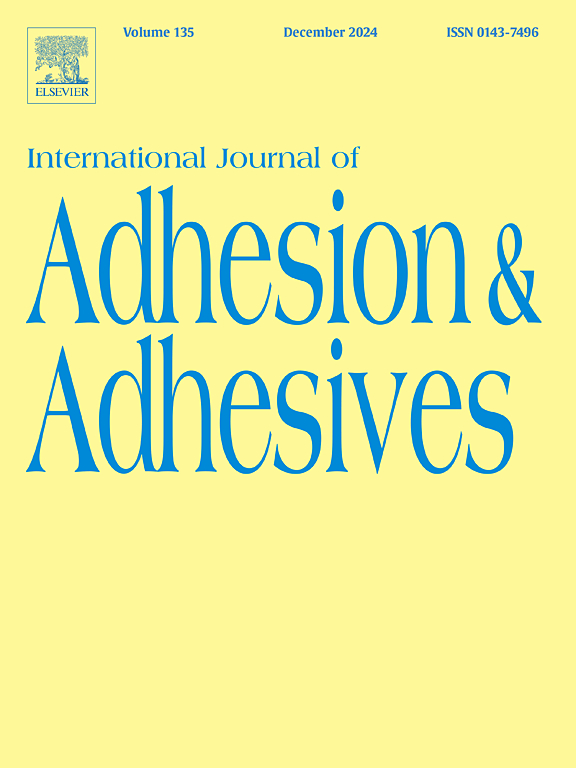Synergistic effects of a bionic villi structure and multiple hydrogen bonds on the increase in interfacial bonding strength of a 30-wt.% GF/PET-2024 aluminum alloy
IF 3.2
3区 材料科学
Q2 ENGINEERING, CHEMICAL
International Journal of Adhesion and Adhesives
Pub Date : 2024-12-24
DOI:10.1016/j.ijadhadh.2024.103932
引用次数: 0
Abstract
In recent years, metal‒thermoplastic polymer hybrid joints have been widely used in lightweight advanced aircraft and new energy vehicles. In this work, the method of machine milling + FeCl3 corrosion + coating KH-892 was used to construct a viscous bionic villi structure on the surface of A2024 aluminum alloy, which greatly improved the interfacial bonding strength of a 30-wt.% glass fiber-reinforced PET-A2024 aluminum alloy joint (expressed as 30-wt.% GF/PET-A2024 joint). The synergistic action of the millimeter column produced by milling and the micron-scale porous structure produced by corrosion results in multiscale mechanical interlocking and increases the interfacial bonding strength of 30-wt.% GF/PET-A2024 to 44.2 MPa, which is 13.7 times greater than that of untreated joint. FTIR results show that the KH-892 coating can change the viscosity of the villi surface, which makes it easier for the bionic villi surface to bond with PET. Under the action of millimeter‒micron multiscale mechanical interlocking and multiple hydrogen bonds, the interfacial bonding strength of 30-wt.% GF/PET-A2024 increases to 54.8 MPa.
仿生绒毛结构和多个氢键的协同作用对30wt的界面结合强度增加的影响。% GF/PET-2024铝合金
近年来,金属-热塑性聚合物混合接头在轻型先进飞机和新能源汽车上得到了广泛的应用。本文采用机铣+ FeCl3腐蚀+涂层KH-892的方法,在A2024铝合金表面构建了粘性仿生绒毛结构,大大提高了30wt的界面结合强度。%玻璃纤维增强PET-A2024铝合金接头(表示为30-wt。% GF/PET-A2024接头)。铣削产生的毫米柱与腐蚀产生的微米尺度多孔结构的协同作用导致多尺度机械联锁,提高了30-wt的界面结合强度。% GF/PET-A2024达到44.2 MPa,是未处理接头的13.7倍。FTIR结果表明,KH-892涂层可以改变绒毛表面的粘度,使仿生绒毛表面更容易与PET结合。在毫米-微米多尺度机械联锁和多个氢键的作用下,界面结合强度达到30-wt。% GF/PET-A2024增加到54.8 MPa。
本文章由计算机程序翻译,如有差异,请以英文原文为准。
求助全文
约1分钟内获得全文
求助全文
来源期刊

International Journal of Adhesion and Adhesives
工程技术-材料科学:综合
CiteScore
6.90
自引率
8.80%
发文量
200
审稿时长
8.3 months
期刊介绍:
The International Journal of Adhesion and Adhesives draws together the many aspects of the science and technology of adhesive materials, from fundamental research and development work to industrial applications. Subject areas covered include: interfacial interactions, surface chemistry, methods of testing, accumulation of test data on physical and mechanical properties, environmental effects, new adhesive materials, sealants, design of bonded joints, and manufacturing technology.
 求助内容:
求助内容: 应助结果提醒方式:
应助结果提醒方式:


